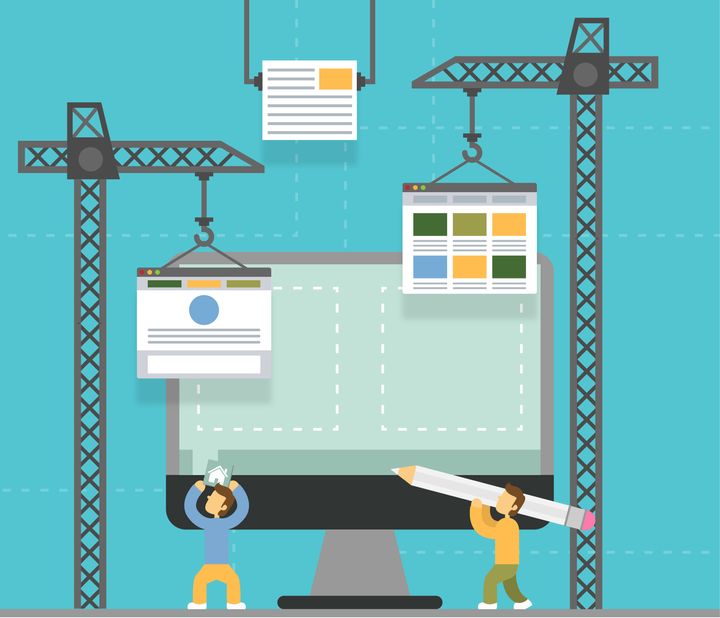
designed by freepik.com
Good web design requires the seamless combination of two key factors: aesthetics and usability. Having a beautiful and easy to navigate site creates a positive first impression and increases the odds that users will actually engage with your brand. Whether business is done online, in-store or both, your website may well be the first thing potential customers see. According to a recent study by Bazaarvoice, “82% of shoppers say they consult their phones about a purchase they’re about to make inside a store,” which means that a majority of your potential customers will visit your website before making a purchase.
Having a well-designed and high functioning website is vital to providing an enjoyable online experience for your visitors, and thanks to page builders like BoldGrid that work on top of WordPress to simplify the process, you can do it all yourself. But before diving into the world of web design, you should do your homework to see what works and what doesn’t. Here are a few common pitfalls to avoid:
1.) Lacking or Poor Call to Action (CTA)
The CTA should be one of the most prominently-displayed and visually exciting elements on your website. It should clearly communicate what you want visitors to do once they land on your site and provide an easy path for doing so. Consider having a clickable CTA button to help your visitors get to the next step.
Support your CTA with language describing the value of your product or service along with a compelling reason for why that visitor should act now. The verbiage used should be straightforward and concise to ensure the visitor knows exactly what they are clicking and what they will get out of it. Even if you are not directly selling goods, a good CTA can be used for other objectives like building contact lists.
Again, page builders like BoldGrid can help, as many provide themes designed by industry professionals with CTA ideation already in place. Just adjust the default text to reflect your goals and you’re good to go.
2.) Long/Slow Load Times
Load time is a huge factor in page abandonment and bounce rates. Monitor features that slow down your website and remove the ones that aren’t essential and/or are failing to generate user engagement.
A visitor’s decision to stay on your site or move on happens very quickly. Recent research by KISSmetrics shows that 47 percent of website visitors expect a page to load in under two seconds and 40 percent of website visitors abandon a website that takes more than three seconds to load. If a visitor decides to move on because of slow site performance, it’s unlikely that they will return in the future.
If you’re using WordPress, I suggest using the JCH Optimize plugin which automatically performs several front-end optimizations that will help content load faster.
3.) Cluttered or Unorganized Content
Don’t be afraid of whitespace. The content on your site provides little value if it’s difficult to read and/or makes pertinent information hard to find. Building pages with too much text is one of the biggest mistakes I see novice designers make. Instead, break up large blocks of text into digestible chunks and use images to create space between text. Proper use of whitespace on your site will help guide visitors to the content you want them to absorb rather than overwhelming them to the point that they drop off.
If you’re having trouble, I recommend using a page builder with pre-installed themes that utilize the latest design trends to provide a foundation to build upon.
4.) Lack of Share Buttons and Social Media Integration
Social media is an unavoidable facet of society and plays a key role in digital marketing. A study conducted by Social Media Examiner reports that “89% of all marketers indicated that their social media efforts have generated more exposure for their businesses. Increasing traffic was the second major benefit, with 75% reporting positive results.” A robust social media strategy goes a long way in terms of driving consumer engagement and personally connecting with customers. This helps foster long-term relationships which strengthens brand loyalty.
If your site has a blog, I strongly suggest promoting blog content via social media to improve search engine optimization (SEO). This makes your site easier to find when using search engines like Google, Bing and Yahoo.
5.) Inconsistent Font Styles, Colors and Design
Use one template for all pages on your site with navigation tools clearly displayed throughout to ensure consistency. Varying design styles will confuse your visitors and create a disconnect whereas consistency subconsciously communicates stability. Stick to a couple of fonts and two or three colors per page. Consider pre-built templates as they enable you to easily change fonts and colors across your entire site to ensure consistency throughout.
6.) Poor Navigation
It’s of paramount importance that your website is easy to navigate with an intuitive design. Provide a clearly marked toolbar that allows visitors the option to immediately jump to the section of your site that interest them most – and make sure it is prominently displayed on every page. Links should also be accurately labeled so that the visitor knows exactly where they are headed before clicking through.
7.) Lack of Contact Info
Communication is a two-way street, and the moment someone visits your website, he or she should have an easy way to contact your organization. A "Contact Us" page is the obvious answer here, but it’s also a good idea to include contact info in the footer or header of your site so that it’s accessible at all times. Once you have contact information on your site, be sure to check for incoming messages regularly. All inbound correspondence should be addressed as soon as possible to maintain a high level of customer satisfaction.
Web design is challenging, but it doesn’t have to be impossible. Whether you’re building a website from scratch or updating the one you already have, make sure to avoid the aforementioned pitfalls and you’ll stay ahead of the curve.
